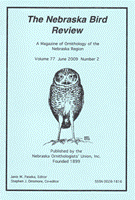Nebraska Ornithologists' Union
Date of this Version
3-2004
Citation
Nebraska Bird Review (March 2004) 72(1).
Abstract
Last year, I wrote: "Overall, this was a pretty quiet winter season. There were no major weather events, no major invasions (just one minor incursion), and, with one big exception, no real rarities." This is pretty much true of this winter too, except that there weren't even any minor incursions, unless Common Redpoll and Purple Finch qualify, and no drop-dead rarities, although Black-headed Gull comes close! In fact, we returned to a fairly normal type of winter with some cold weather and accumulating snow cover. This caused birds to leave in fall in normal fashion, and, in general, to arrive in spring at normal times. Waterfowl and blackbirds generally departed in early Jan and returned at the end of February, just like old times, and there were some half-hardy birds in evidence: Yellow-bellied Sapsucker, Hermit Thrush, Yellow-rumped Warbler, Fox Sparrow, and Brown-headed Cowbird. A surprise was the absence of scoters. There was a minor influx of Common Redpolls and Purple Finches, but other winter finches were in low numbers. Clearly declining in recent years, especially when compared to CBC numbers of around 20 years ago, is the House Sparrow. Numbers of Harris's Sparrow also were low, as were chickadees, the latter strikingly so in the Platte Valley. Huge numbers of robins, starlings, and crows were reported, as well as Canada Geese in the central and western Platte Valley. Eurasian Collared-Doves continued to occupy new counties, with only 17 unsullied; interestingly, 12 of these are Sandhills counties.
There were few late dates set; a Rock Wren was most noticeable, being 2 months later than the previous late date, and an Eared Grebe and a Lincoln's Sparrow were both 2nd latest ever for fall, the latter possibly wintering. Rare midwinter records were a Barn Owl and a Savannah Sparrow. Almost old friends were the Tufted Duck at Lake Ogallala, back for the 5th year, and the Curve-billed Thrasher in Sioux County. A genuine rarity was a Black-headed Gull, only the 3rd state record (2nd acceptably documented, pending NOURC). Other rare birds were all gulls at Lake McConaughy, truly an incredible gulling experience this winter. The list of 12 species found there included Little Gull (13th state record), Great Black-backed Gull (14th), Iceland Gull (17th), and Mew Gull (19th). Far out of range for winter was a Carolina Wren in Scotts Bluff County.


Comments
Copyright 2004, Nebraska Ornithologists' Union. Used by permission.